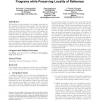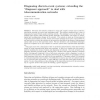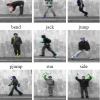2479 search results - page 90 / 496 » Random Event Structures |
DRM
2007
Springer
14 years 3 months ago
2007
Springer
We introduce a data structure for program execution under a limited oblivious execution model. For fully oblivious execution along the lines of Goldreich and Ostrovsky [2], one tr...
OOPSLA
2004
Springer
14 years 2 months ago
2004
Springer
Radio Frequency Identification (RFID) technology provides the means to track any object, any time, anywhere with Electronic Product Codes (EPC). A major consequence of this techno...
DEDS
2002
13 years 8 months ago
2002
Abstract. Detection and isolation of failures in large and complex systems such as telecommunication networks are crucial and challenging tasks. The problem considered here is that...
INFOCOM
2010
IEEE
13 years 7 months ago
2010
IEEE
—Upon the occurrence of a phenomenon of interest in a wireless sensor network, multiple sensors may be activated, leading to data implosion and redundancy. Data aggregation and/o...
CVPR
2009
IEEE
15 years 4 months ago
2009
IEEE
We present a new method for classification with structured
latent variables. Our model is formulated using the
max-margin formalism in the discriminative learning literature.
We...



